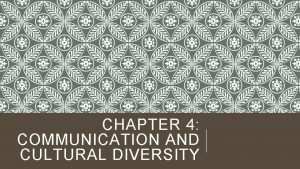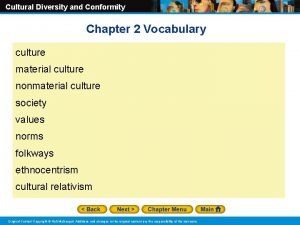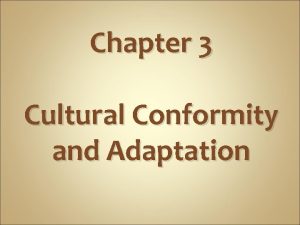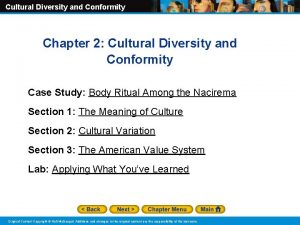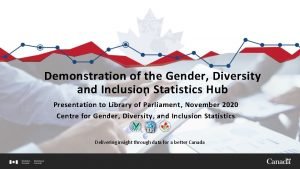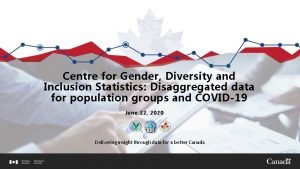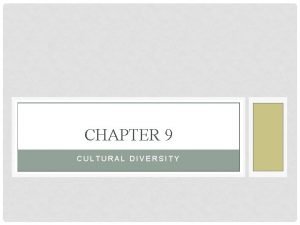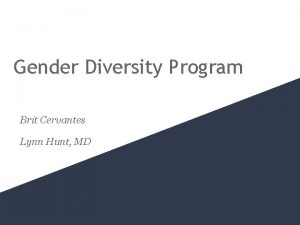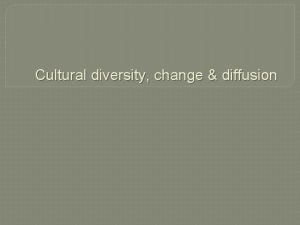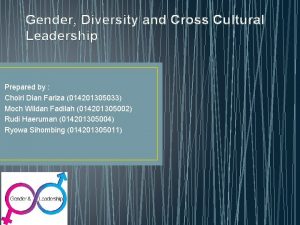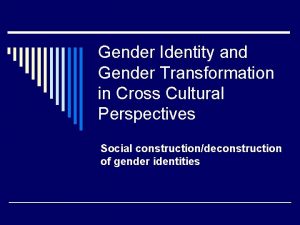Chapter 15 Gender Diversity and Cross Cultural Leadership















- Slides: 15

Chapter 15 Gender, Diversity, and Cross. Cultural Leadership Copyright © 2010 Pearson Education, Inc. Leadership in Organizations 15 -1

Learning Objectives Understand why cross-cultural research on leadership is important. n Understand different types of crosscultural research. n Understand the difficulties of studying cross-cultural leadership. n Understand how cultural values are related to beliefs about effective Copyright © 2010 leadership. Pearson Education, Inc. Leadership in Organizations 15 -2 n

Learning Objectives (Cont. ) Understand how cultural values can influence leader behavior. n Understand how gender issues have been studied and the limitations of this research. n Understand the findings in research on gender differences in leadership. n Understand how to manage diversity and Copyright © 2010 provide Pearson Education, Inc. Leadership in Organizations 15 -3 equal opportunities. n

Introduction to Cross-Cultural Leadership n Importance of Cross-Cultural Research n n Increasing globalization Leaders need to influence people from other cultures Leaders need to understand how others interpret their actions Cultural Influences on Leadership Behavior Copyright © 2010 Pearson Education, Inc. Leadership in Organizations 15 -4

Cross-Cultural Leadership Research: Types and Difficulties n n Types of Cross-Cultural Studies Methodological Problems n n n Lack of equivalence of meaning for measures Confounding effects Response bias Lack of representative samples Level of analysis problems Copyright © 2010 Pearson Education, Inc. Leadership in Organizations 15 -5

Cross-Cultural Leadership Research: Types and Difficulties (Cont. ) n n Cross-Cultural Research on Behavior Differences Examples of Research on the Effects of Behavior n n n Lowe, 1999 Dorfman and colleagues, 1997 Schaubroech, Lam, and Cha, 2007 Copyright © 2010 Pearson Education, Inc. Leadership in Organizations 15 -6

The GLOBE Project Table: Cultural Beliefs about Ideal Leader Attributes Copyright © 2010 Pearson Education, Inc. Leadership in Organizations 15 -7

Cultural Value Dimensions and Leadership n n n Power Distance Uncertainty Avoidance Individualism (vs. Collectivism) Gender Egalitarianism Performance Orientation Human Orientation Copyright © 2010 Pearson Education, Inc. Leadership in Organizations 15 -8

Table: Globe Culture Clusters Copyright © 2010 Pearson Education, Inc. Leadership in Organizations 15 -9

Evaluation of the Cross. Cultural Research 1. How does actual behavior of leaders differ across cultural value clusters and for different countries? n 2. How are leader values and behaviors jointly influenced by personality (and developmental experiences), company culture, and national culture? n 3. How useful is the distinction between actual and ideal cultural values for understanding implicit theories of leadership and patterns of Copyright © 2010 Pearson Education, Inc. 15 -10 leadership behavior? Leadership in Organizations n

Evaluation of the Cross. Cultural Research (Cont. ) 4. How difficult is it to change an organization’s cultural values when they are not consistent with the societal values where the organization’s facilities are located? n 5. How fast are cultural values changing, and what are the primary determinants of culture changes that are relevant for leadership? n 6. What types of leadership traits, skills, and developmental experiences are most useful to prepare someone for a leadership assignment in Copyright © 2010 Pearson Education, Inc. 15 -11 a different culture? Leadership in Organizations n

Gender and Leadership Sex-Based Discrimination n Explanations for the Glass Ceiling n Theories of Feminine Advantage n Findings in Research on Gender Differences n Limitations on Research on Gender Differences n Identifying Causes and Reducing Copyright © 2010 Pearson Education, Inc. Leadership in Organizations Discrimination n 15 -12

Managing Diversity Table: Guidelines for Managing Diversity Copyright © 2010 Pearson Education, Inc. Leadership in Organizations 15 -13

Managing Diversity (Cont. ) n n Fostering Appreciation and Tolerance Providing Equal Opportunity Copyright © 2010 Pearson Education, Inc. Leadership in Organizations 15 -14

All rights reserved. No part of this publication may be reproduced, stored in a retrieval system, or transmitted, in any form or by any means, electronic, mechanical, photocopying, recording, or otherwise, without the prior written permission of the publisher. Printed in the United States of America. Copyright © 2010 Pearson Education, Inc. Leadership in Organizations 15 -15
 Strategic gender needs and practical gender needs
Strategic gender needs and practical gender needs Importance of cross cultural leadership
Importance of cross cultural leadership Chapter 4 communication and cultural diversity
Chapter 4 communication and cultural diversity Cultural diversity vocabulary
Cultural diversity vocabulary Cultural diversity and conformity chapter test form a
Cultural diversity and conformity chapter test form a Examples of countercultures
Examples of countercultures Chapter 13 cultural diversity and community health nursing
Chapter 13 cultural diversity and community health nursing Cultural diversity 3939 answers
Cultural diversity 3939 answers Centre for gender diversity and inclusion statistics
Centre for gender diversity and inclusion statistics Centre for gender diversity and inclusion statistics
Centre for gender diversity and inclusion statistics Ifrc gender and diversity policy
Ifrc gender and diversity policy Chapter 9 cultural competence
Chapter 9 cultural competence Chapter 10 cultural diversity
Chapter 10 cultural diversity Brit cervantes
Brit cervantes Genetic diversity and biodiversity
Genetic diversity and biodiversity Genetic diversity vs species diversity
Genetic diversity vs species diversity


